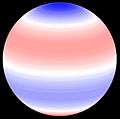Xi Hydrae
| Observation data Epoch J2000.0 Equinox J2000.0 | |
|---|---|
| Constellation | Hydra |
| Right ascension | 11h 33m 00.10s |
| Declination | −31° 58′ 28.0″ |
| Apparent magnitude (V) | 3.54[1] |
| Characteristics | |
| Spectral type | G7 III[1] |
| Astrometry | |
| Distance | 129.275 ly (39.635 pc) |
| Details | |
| Mass | 2.89 ± 0.23[2] M☉ |
| Radius | 10.2 ± 0.1[2] R☉ |
| Luminosity | 57.65 ± 2.39[2] L☉ |
| Temperature | 4,984 ± 54[2] K |
| Metallicity [Fe/H] | +0.21[2] dex |
| Rotational velocity (v sin i) | 2.7[2] km/s |
| Other designations | |
Xi Hydrae (ξ Hya, ξ Hydrae) is a fourth-magnitude star in the constellation Hydra. The star is situated 130 light-years from Earth and has a radius about 10 times that of the Sun. It is radiating 58 times as much luminosity as the Sun.[2] The star is now approaching the end of its life, and has expanded its outer envelope to become a red giant star.
The star Xi Hya was particularly interesting in the field of asteroseismology when an international group of astronomers discovered that it behaves like a giant sub-ultra-bass musical instrument.[3]
Xi Hydrae was a latter designation of 19 Crateris.[4]
-

Xi Hydrae.
References
- 1 2 Mallik, Sushma V. (December 1999), "Lithium abundance and mass", Astronomy and Astrophysics, 352: 495–507, Bibcode:1999A&A...352..495M
- 1 2 3 4 5 6 7 Bruntt, H.; et al. (July 2010), "Accurate fundamental parameters for 23 bright solar-type stars", Monthly Notices of the Royal Astronomical Society, 405 (3): 1907–1923, arXiv:1002.4268
 , Bibcode:2010MNRAS.405.1907B, doi:10.1111/j.1365-2966.2010.16575.x
, Bibcode:2010MNRAS.405.1907B, doi:10.1111/j.1365-2966.2010.16575.x - ↑ http://www.innovations-report.com/html/reports/physics_astronomy/report-9950.html
- ↑ Wagman, M. (August 1987). "Flamsteed's Missing Stars". Journal for the History of Astronomy, Vol.18, NO. 3/AUG, P.209, 1987. 18: 216. Bibcode:1987JHA....18..209W.
External links
- Wisky.org Star Catalogue
- ESO Article: The Ultrabass Sounds of the Giant Star Xi Hya.
- Listen to Xi Hya (mp3).
This article is issued from Wikipedia - version of the 9/12/2016. The text is available under the Creative Commons Attribution/Share Alike but additional terms may apply for the media files.